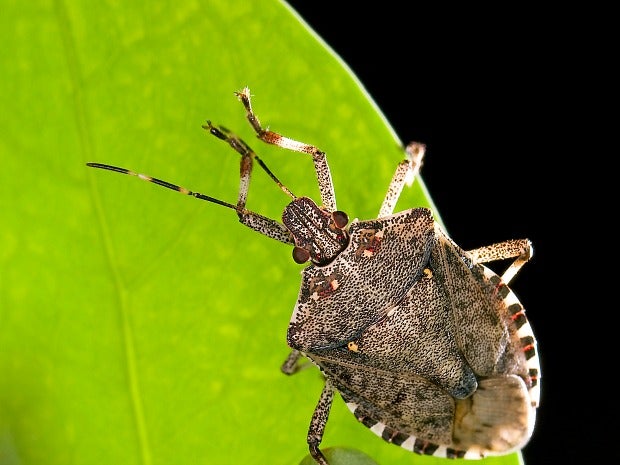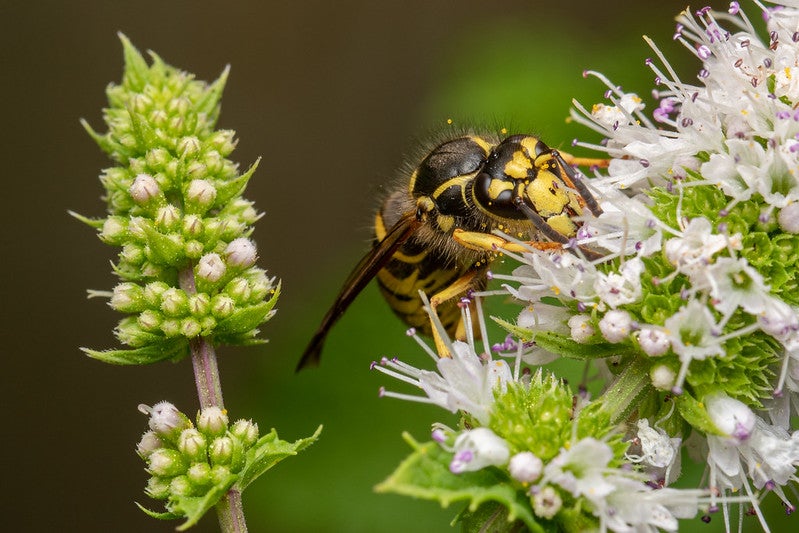As growers and agriculture researchers have learned during the brown marmorated stink bug’s 20-year migration across the U.S., managing the pest is difficult.
Multiple naturally occurring substances can help control the bug. Several essential oils repel it. Most effective are clove, lemongrass, spearmint and ylang-ylang oils, while geranium, rosemary and wintergreen have limited power to repel. But all of these oils’ effects are temporary. Biopesticides, including microbes and chemicals that plants create as natural defense mechanisms, also come in handy for managing this bug.
Synthetic pesticides have varying levels of efficacy, and the species is able repopulate a given area following treatment.
Stay informed on the latest news
Sign up for WPR’s email newsletter.
“Using insecticides is not recommended,” said PJ Liesch, an entomologist with the UW Insect Diagnostic Lab. “If large numbers of stink bug adults were killed in a home and not properly removed, it could actually encourage other insects to show up to feed on the dead ones.”
Given the brown marmorated stink bug is relatively new to North America, many insecticide labels do not mention the species by name, notes a UW-Extension guide. Broad spectrum pesticides — compounds that contain organophosphates, carbamates and neonicotinoids, and target many species at once — may be effective for managing the bug. But narrow spectrum pesticides, those that target specific species or small groups of them, are not likely to work. The guide emphasizes that insecticides should only be used if they’re effective with reducing the bug’s numbers, and their use should be immediately discontinued if not, as resistance may develop.
“Broad-spectrum” pesticides kill beneficial insects in addition to pests, and a one-time application isn’t enough to keep a brown marmorated stink bug off an individual apple or peach.
“The bug is very mobile and constantly invading the crop, so we have to keep the pesticide on the fruit consistently,” said Anne Nielsen, an entomologist at Rutgers University in New Jersey. This frequent spraying intensifies the damage synthetic pyrethroids and neonicotinoids do to non-invasive insects that occasionally prey on the brown marmorated stink bug.
Nielsen has led extensive research efforts into how farmers can combat the brown marmorated stink bug, including on organic farms. For non-organic farms (i.e., ones that use pesticides), she has worked with growers to develop strategies to minimize damage from broad-spectrum chemicals. The key, Nielsen said, is to understand the bug’s behavior.
One potential method to control the bug in an agricultural setting may be to rely on the tendency of brown marmorated stink bugs to first focus on the edge of a crop to feed. That means a grower can apply insecticide along the edges of the field — about 25 percent of the crop — before the bugs move into its interior. This “reduced input” method controlled brown marmorated stink bugs in peach and apple orchards in a study by the U.S. Department of Agriculture’s Sustainable Agriculture Research & Education program. These “border sprays,” as Nielsen calls them, are frequent, but ideally they keep the bug from penetrating too far into the crop and minimize the amount of beneficial insects killed.
The second approach Nielsen has developed involves putting pheromone-baited traps along a field’s outer edge to attract large numbers of the bugs and kill them en masse all in one small area, rather than spraying widely.
Nielsen and her collaborators have also explored non-pesticide strategies that organic farmers can use. They include planting sunflowers and sorghum near orchards as “trap crops” to draw the bugs away from the actual cash crops, and trying to trap the bugs while they are overwintering.
Ideally, Nielsen said, growers should combine multiple strategies for killing brown marmorated stink bugs, because once the insects move into an area, they’re a pest for good. Working with peach growers in New Jersey, she has demonstrated that new strategies can keep the bug under control. “In really bad years we’ve had 60 to 90 percent losses (in peach crops),” Nielsen said. “But in a normal year, now that we have management practices in place, the damage is significantly less.”
Growers do have some natural allies in combating the brown marmorated stink bug, but they’re fickle. As an invasive species, the bug doesn’t have a predator in the United States that specifically targets it. Even species that could prey on the bug aren’t looking for it in the U.S. habitat and haven’t developed a taste for it. Kim Hoelmer, a USDA research entomologist, said a lot of American insects will occasionally feed on stink bugs, “but they’re not targeting them as a major prey item… those natural enemies, they’re not of much help.”
In East Asia, where the bug originates, a parasitic wasp (Trissolucus japonicus) singles out brown marmorated stink bug eggs, laying its own eggs amid them so its own larvae can eat them. In the United States, Nielsen said, various species of damsel bugs, katydids, birds, bats, spiders and even native stink bugs will eat the brown marmorated stink bug or its eggs, “but these are generalist predators, so they’re not cueing in on stink bug eggs.”
The good news is that the bug’s occasional U.S. predators prey on it at different life stages, some targeting eggs and some targeting immature young, or nymphs.
To strengthen biological control of the pest scientists at the U.S. Department of Agriculture have explored the possibility of importing the parasitic wasp. Since 2007, USDA scientists in a quarantined lab have been studying Trissolcus japonicus to see whether it also presents a threat to other American species — that is, whether introducing it in the U.S. to control the stink bug would essentially create another invasive-species problem. Results have been mixed, said Hoelmer, who works on the project.
“They only attack stink bug eggs, and they don’t attack all stink bugs… but in the lab, they will attack other species that occur in North America,” Hoelmer said. But an insect’s behavior in quarantined experiments, where it’s simply the wasp and the stink bugs isolated together, doesn’t always translate to behavior in the field, where other species and ecological conditions have an influence. The researchers are working on the next step, trying to create lab conditions that more closely approximate field conditions.
Nielsen said it’s not clear whether japonicus wasps released here would follow the stink bugs into crop fields. “In Asia it’s very efficient in terms of egg predation, but what we don’t know about the U.S. population yet is if it will move into crops or if the populations will be constrained into the wood edge,” she said.
In the meantime, Trissolcus japonicus has made its way to the U.S. on its own, likely brought here by accident just like its natural prey. Researchers studying the stink bug discovered the wasp in Maryland in 2014, and in Vancouver, Washington, in 2015.
Hoelmer said it’s not clear how fast the wasps will spread in the U.S., but they’ve already survived one winter on the East Coast.
“If it spreads on its own and has the kind of impact we hope it would have, then we wouldn’t need to continue our lab testing,” he said. If not, the USDA might try releasing its lab population of the wasps into the field.
For gardeners concerned about the bug, Liesch said the best thing to do is simply keep an eye out for it and remove by hand any that are found or to use row covers to block them and other small insects.
To keep the bugs out of homes, the Wisconsin Department of Agriculture, Trade and Consumer Protection recommends caulking around windows, doors, siding, utility pipes, chimneys and other openings with silicone or silicone-latex caulk to seal any spaces. If the bugs are already inside a structure, caulking around interior trim, exhaust fans and ceiling lights will help contain them.
Penn State Extension advises against using insecticides to control the bugs after they have made their way into a structure. Aside from issues related to pesticide safety, large number of stink bug carcasses may attract other insects to feed on them, which may in turn cause an infestation of their own. Moreover, insecticides do not prevent subsequent colonization, and are not considered an effective long-term deterrent.
Crushing the stink bugs is not “advised as the odoriferous chemicals will ooze out and other bodily fluids may cause staining on fabrics or other surfaces,” said Liesch. Small numbers can be knocked into a container of soapy water to kill them. Even though they can smell when disturbed, vacuuming may be the best option for removing stink bugs, Liesch said, but the bag should be removed and discarded right away.
This report was produced in a partnership between Wisconsin Public Radio, PBS Wisconsin and the University of Wisconsin Cooperative Extension. @ Copyright 2025, Board of Regents of the University of Wisconsin System and Wisconsin Educational Communications Board.

